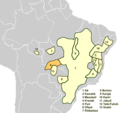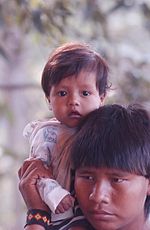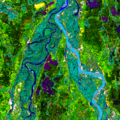Karajá, also known as Iny rybè,: 1 is a Macro-Jê spoken by the Karajá people in some thirty villages in central Brazil. There are distinct male and female...
31 KB (3,285 words) - 16:15, 21 April 2025
The Karajá, also known as Iny, are an indigenous tribe located in Brazil. Karajá people live in a 180-mile-long area in central Brazil, in the states of...
11 KB (1,363 words) - 17:09, 3 March 2025
Karaja or Karajá may refer to: Karajá, an indigenous tribe of Brazil Karajá language Karaja (singer) (born 1978), German musician Karaja, Iran, a village...
318 bytes (80 words) - 11:50, 3 July 2023
borrowed from Karajá werikòkò, lala, wii, bikòwa, bèrò.: 13 Loanwords from Brazilian Portuguese are found in many, if not all, Macro-Jê languages spoken in...
19 KB (1,618 words) - 20:28, 19 April 2025
Andative and venitive (category Articles containing Karajá-language text)
sumerologists use the variant term ventive rather than venitive. Karajá, a Macro-Jê language of central Brazil, is unusual in requiring all verbs to be inflected...
9 KB (1,236 words) - 01:35, 4 July 2024
speakers.: 415 Similarly, Cariban borrowings are also present in the Karajá languages. Karajá speakers had also adopted ceramic technology from Cariban speakers...
12 KB (966 words) - 20:40, 19 April 2025
Mẽbêngôkre has been in contact with the distantly related Karajá language, as evidence by a number of Karajá loanwords in Mẽbêngôkre, especially in the dialect...
42 KB (3,267 words) - 20:53, 19 April 2025
Kamakanan † Kapixaná (Brazil: Rondônia) (also known as Kanoé, Kapishaná) Karajá Karirí (Brazil: Paraíba, Pernambuco, Ceará) † Katembrí † Katukinan (3) (also...
106 KB (6,626 words) - 20:23, 21 April 2025
Consciously devised language Endangered language – Language that is at risk of going extinct Ethnologue#Language families Extinct language – Language that no longer...
34 KB (302 words) - 22:14, 5 April 2025
Puinave-Nadahup languages, Jolkesky (2016) notes that there are lexical similarities with the Tupian, Harakmbet, Katukina-Katawixi, Arawak, and Karaja language families...
6 KB (683 words) - 17:47, 10 October 2022
Voiced dental and alveolar implosives (category Articles containing Karajá-language text)
alveolar implosive is a type of consonantal sound, used in some spoken languages. The symbol in the International Phonetic Alphabet that represents this...
7 KB (528 words) - 20:11, 16 February 2025
Jeoromitxi, Karaja, Rikbaktsa, and Tupi language families due to contact. Extensive lexical similarities between Cariban and various Macro-Jê languages suggest...
75 KB (1,745 words) - 05:25, 23 April 2025
An endangered language is a language that it is at risk of falling out of use, generally because it has few surviving speakers. If it loses all of its...
26 KB (85 words) - 14:08, 2 February 2025
Katukina-Katawixi, Arawak, Bororo, Karaja, Macro-Mataguayo-Guaykuru, Takana, Nadahup, and Puinave-Kak language families due to contact. When the Portuguese...
28 KB (1,186 words) - 03:33, 12 April 2025
Guaykurú Het (Chechehet) Huari Itonama Kahuapana Kaliána Kañari Kanichana Karajá (Karayá) Karib Karirí Katukina Kayuvava Kichua Koche (Mokóa) Kofane Leko...
89 KB (2,424 words) - 19:50, 21 April 2025
The indigenous languages of South America are those whose origin dates back to the pre-Columbian era. The subcontinent has great linguistic diversity...
62 KB (4,818 words) - 18:29, 17 March 2025
extinct languages of Northeast Brazil have also been included from Meader (1978) and other sources. Tupían Arawakan Cariban Macro-Jê Karajá Ofayé Rikbáktsa...
128 KB (10,025 words) - 19:08, 21 April 2025
identify their language and themselves, both in Portuguese and in the Tapirapé language. Ribeiro (2012) finds a number of Apyãwa loanwords in Karajá (such as...
8 KB (705 words) - 00:31, 16 January 2025
northwestern Jê; the Xavante, the Xerente, and the Akroá of the central Jê; the Karajá; the Jeikó; the Kamakán; Maxakalí; the Guayaná; the Purí (Coroado); the...
2 KB (99 words) - 13:29, 4 October 2024
Xambioá (redirect from Karajá do Norte)
people in 1959. Karajá do Norte population is slowly beginning to recover. The present Karajá do Norte population is 268 people. KARAJÁ DO NORTE Archived...
2 KB (145 words) - 19:45, 18 March 2025
eye is round in shape. The name berohoka means "big river" in the Karajas language. It can be found near the Araguaia River and near Itiquira. It can...
4 KB (439 words) - 21:12, 10 December 2024
Araguaia River (category Articles containing Portuguese-language text)
The Araguaia River (Portuguese: Rio Araguaia [ˈʁi.u aɾaˈɡwajjɐ], Karajá: ♂ Berohokỹ [beɾohoˈkə̃], ♀ Bèrakuhukỹ [bɛɾakuhuˈkə̃]) is one of the major rivers...
11 KB (832 words) - 06:17, 27 December 2024
The following is a list of proposed language families, which connect established families into larger genetic groups (macro-families). Support for these...
19 KB (521 words) - 04:19, 10 March 2025
Zayn al-Din Qaraja (redirect from Karaja Beg)
Zayn al-Din Qaraja Beg (Turkish: Zeyneddin Karaca Bey; c. 1279 – 11 December 1353) was a Turkoman chieftain who founded the Dulkadirid principality in...
13 KB (1,524 words) - 10:46, 10 January 2025
Rite of passage (category CS1 French-language sources (fr))
anthropology as well as into the literature and popular cultures of many modern languages. In English, Van Gennep's first sentence of his first chapter begins:...
25 KB (2,914 words) - 18:24, 22 April 2025
Aromanians (category CS1 Romanian-language sources (ro))
Stan Karbunarë, Skrapar, Pojan, Bilisht and Korçë, and that they inhabited Karaja, Lushnjë, Moscopole, Drenovë (Aromanian Dãrnova) and Boboshticë (Aromanian...
78 KB (7,988 words) - 02:40, 24 April 2025
Bolivia Moxos – Bolivia Ignaciano – Bolivia Trinitario – Bolivia Macro-Gê Karajá Gê Kaingáng Canela Tupian Tupinambá – Brazil Guaraní – Paraguay Chiriguano...
12 KB (672 words) - 18:31, 17 March 2025
Masakará † (Masacará) Kapixaná (Kanoê, Capixana) Karajá (Caraja, Xambioá, Chamboa, Ynã, Karayá) Karajá-Xambioá † (Chamboa, Ynã) Javaé (Javaje, Javae) Karirían...
190 KB (4,385 words) - 06:26, 6 April 2025
Bananal Island (category Articles containing Portuguese-language text)
is indigenous. At least four tribes live on Bananal Island: the Javaés, Karajá, Ava-Canoeiro, and Tuxá. There are sixteen aldeias or villages on the island:...
5 KB (438 words) - 00:08, 19 January 2025
List of Indigenous peoples of Brazil (category Articles containing Portuguese-language text)
or Native peoples. This is a sortable listing of peoples, associated languages, Indigenous locations, and population estimates with dates. A particular...
35 KB (498 words) - 14:16, 21 April 2025



















